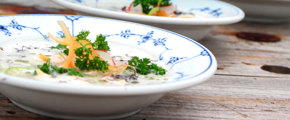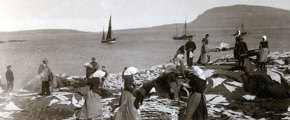Silver smelt
The silver smelt is a small silver and yellowish fish that has a golden shimmer to it, when freshly caught. The Faroese call it Gullaks - Golden Salmon - and its mild flesh works excellently when used in fishcakes.
The silver smelt has white meat that is rich in protein. Its taste and flavour is mild. The high levels of protein result in the meat retaining significant amounts of moisture. This makes the silver smelt ideal for fishcakes and other dishes using minced fish. Silver smelt also work very well as fillets.
The mild taste of the silver smelt lends it well to pairing or mixing with other more spicy or powerful flavours, herbs and spices.
Biology
The silver smelt (Argentina silus) is also called the greater silver smelt, greater Argentine or just Argentine. The fish is part of the Argentinidae family of fish, also called herring smelts. Silver smelt can grow up to 60 cm long, which is significantly longer than other smelt fish that rarely exceed 25 cm in length – hence the name greater silver smelt.
The name most likely derives from the Anglo-Saxon word “smoelt”, which means shiny. In Faroese, silver smelt is called gullaksur, which translates to “golden salmon”.
The silver smelt has a greenish grey and golden colour on the back, the sides are silver, and the stomach is white, with a yellow tinge. When freshly caught, it will have a golden and lilac-blue shine to its skin. The silver smelt is nearly as wide as it is long and has very small, almost translucent fins.
The silver smelt keeps to depths from between 150 metres and 1400 metres. They stay near the seabed during the day and rise up during the night. Their diet mostly consists of crustaceans, krill and smaller fish. Silver smelt in shallower waters are smaller, on average, than those that live in deeper waters.
The silver smelt grows slowly, but the females will grow slightly faster than the males. After a year, the silver smelt is around 10-16 cm long and after 5 years it is about 30 cm long. Only after 10 years does it reach 38 cm in length. They can grow up to 60 cm at the most, at which point they are about 25-30 years and weight about 2 kilograms.
The silver smelt can be found across the northern hemisphere. In the Northeast Atlantic they are found around the Faroe Islands, Iceland, Greenland, Norway, Scotland and Ireland and up in the western parts of the Barents Sea.
The Faroe Islands mostly produce and export silver smelt as minced fish. Faroese vessels mostly fish for silver smelt with trawls in Faroese waters, but sometimes also to the west of the British Isles.




